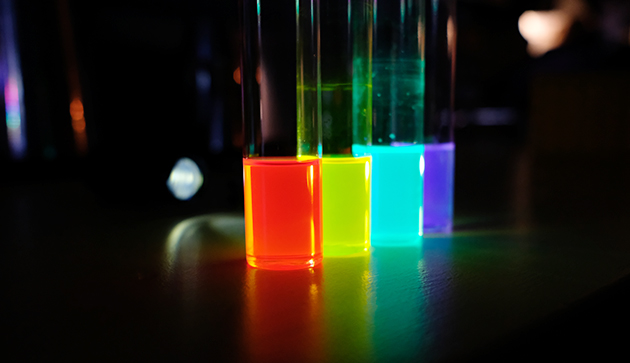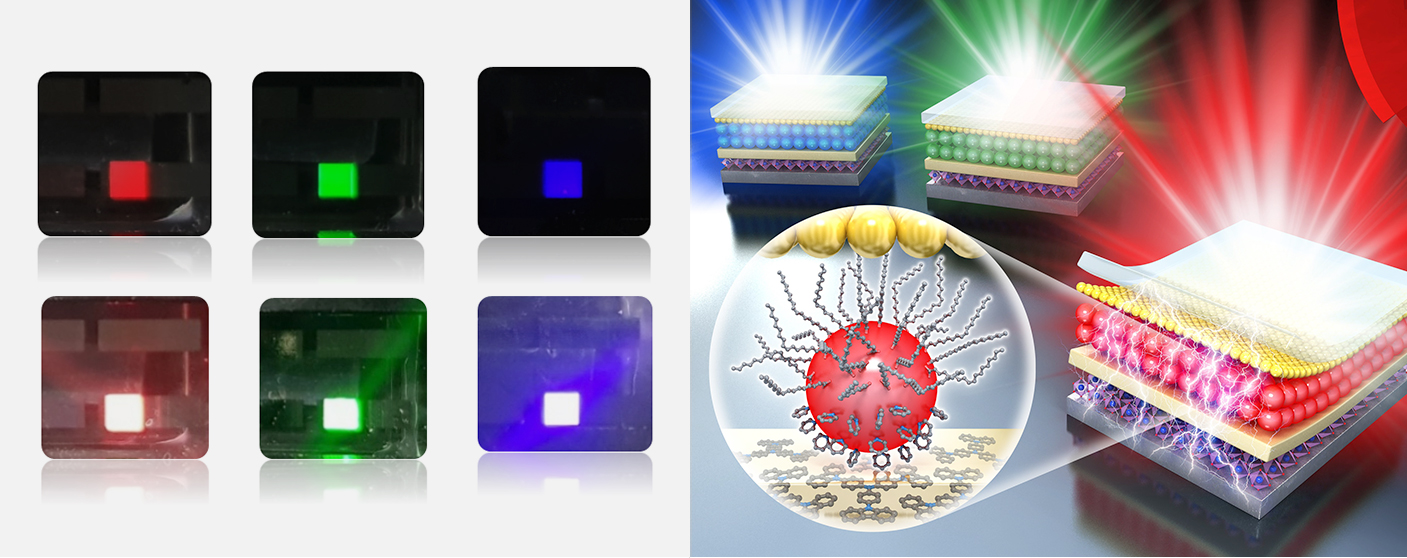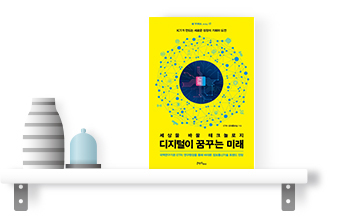VOL.53
June 2019


ICT Trend ____ Quantum Dot Display Technology
Write on Monitor
Using Light
Quantum Dot Display Technology
A joint research group of domestic and international researchers developed next-generation display technology that enables information communications and energy acquisition through light using quantum dots, which are dumbbell-shaped light-sensitive particles. This is known as quantum dot display technology. The invention has opened a new era in which one can write on a monitor by using light and adjusting the amount of light.


Quantum Dot Display that Self-illuminates
In existing TVs and displays, information transfer is allowed only in one direction. It was not possible for the user to give commands or enter information on the TV. Pressure-sensitive touch displays or motion-recognizing remote controllers were released, but most of them were difficult to use, and their recognition performance was not satisfactory. If these items are considered early versions of interactive solutions, the present invention can be regarded as laying the groundwork for the emergence in the future of much more advanced interactive solutions. In the past, information input was made using a remote controller that can recognize the up-and-down and left-and-right directions based on the location of the user. With the invented technology, the user will be able to enter information using light, with a device that resembles a laser pointer. Information input can be conducted in a much more sophisticated manner. Going forward, this technology is expected to be used in various applications, such as electronic blackboards on which one can write using light, self-charging displays that recognize light and motion, motion recognizing screens, and Li-Fi displays that transmit and receive data through light.
As mentioned above, this research was conducted jointly by ETRI in Korea and in the US by the University of Illinois at Urbana-Champaign and Dow. As a result, a light-sensitive display with excellent LED luminescence and light sensing characteristics was developed using quantum dots, i.e., dumbbell-shaped semiconductors. The outcome of the research was published in the world-renowned journal Science in February 2017. The achievement then drew so much attention from the media that I also had a chance to interview Dr. Nuri Oh at the University of Pennsylvania, one of the principal authors of the paper. In this research, quantum dots, recently at the center of attention, were used. Quantum dots refer to semiconductor crystals that self-illuminate and that have a size of tens to hundreds of nanometers. They have already been used in LCD panels and LED backlight devices by domestic TV manufacturers and have taken the name QLEDs.

The upper line refers to existing QLED devices, while the lower line refers to developed QLED devices. / The cover of the journal in which the QLED quantum dot substitution technology developed by ETRI researchers is published
Technology that Implements a New Way of Writing
A quantum dot is characterized by its spherical shape and by its having core and shell parts. There is an energy gap between the two parts. The energy is typically lower in the core part and higher in the shell part. It selectively emits or absorbs the amount of light that corresponds to the energy gap, and thus it can be used in optoelectronic devices, such as solar cells, LEDs, and photodetectors. However, once injected, it is difficult to separate or extract the electrons and holes from these spherical shaped quantum dots. To overcome this limitation, researchers studied and developed dual heterojunction nanorod quantum dots. Quantum dots having core and shell parts are attached to the ends of a nanorod, forming a dumbbell shape. These dumbbell-shaped quantum dots have an asymmetric energy difference. They have a symmetric spherical shape and differ from typical quantum dots with core and shell structures. This unique structure makes it possible to efficiently inject or extract electrons and holes. Also, with the dual heterojunction structure, the transfer of electrons and holes can be separately controlled.
Researchers have also revealed that these dumbbell-shaped quantum dots are capable of improving not only the luminescence characteristics but also the light sensing performance. To verify the applicability of the invented technology for various fields, a 100-pixel model was fabricated on a 1-inch×1-inch substrate and tested for various properties. This research attempted to introduce the principle of the LED, in which light is emitted when energy is lost, and the principle of an optical sensor, in which a current flows when light energy is gained, to quantum dots by changing their structure into a dumbbell shape. The key aspect of the technology is the development of a multiple-function device that can serve as both the LED and the optical sensor. Simply put, this technology makes it possible to fabricate devices using quantum dots that have different shapes from the ones used in the existing QLED devices. Unlike the existing LED that only emits light, the developed device is capable of not only emitting light but also absorbing light, and thus of detecting it as sensors do. This means that the LED device can automatically illuminate itself in an environment without light. Simply put, it automatically adjusts the amount of light.
In the research, a laser pointer was used as an external light source. When detecting light, each LED pixel was designed to allow an external electric signal to flow through itself. Thus, it is possible to write letters on the developed display panel without touching it using a pen or a finger. A video clip recording the research process demonstrated that the letters “UI” could be clearly written following the trace of the tip of a laser pointer. (Here, the symbol UI refers to the abbreviation of the University of Illinois at Urbana-Champaign, where some of the researchers who participated in the research are from.) The technology was successfully implemented, demonstrating that each time they are irradiated with a laser pointer, the concerned pixels became lit. Using the technology, a new way of writing on electronic blackboards or displays will emerge, which will be completely different from what we do today using ink or pens.

Beyond Vision Dreamed by ETRI
As described above, the double functions of emitting and detecting light also mean that visible light communication can be implemented, where one LED pixel communicates with neighboring pixels on the other side while exchanging light with one another. In this research, it was successfully demonstrated that two LED pixels were able to exchange data using the flickering of an LED light at a rate as fast as 50kHz. This also means that the increased number of pixels will possibly improve the data transmission speed and, if this is the case, the technology will make a great contribution to the implementation of Li-Fi, a communication technology using light. Also, it was confirmed that a bilateral light-sensitive display was capable of serving as a solar cell. Four pixels connected in series were electrically charged, and the concerned pixels were then lit using the charged energy. This will make it possible to implement self-charging QLED devices. Based on the developed technology, researchers are attempting to improve the luminescence and light sensing efficiency by adjusting the structure and composition of the used nanoparticles. Also, they are seeking to develop display devices with improved energy conversion efficiency. It is expected to take five to ten years to commercialize this technology.
ETRI emphasized that, “Given that the advancement of display technology will be the key growth engine for the future, it is more important to set the right direction for future research.” ETRI has already initiated the development of technology to enter human biometric data to displays. The fingerprint recognition function of the smartphone is typically implemented as a separate button or using the backside of the smartphone because the fingerprint recognition panel is opaque and thus difficult to apply. Therefore, there is a need to develop transparent touch panels and security sensors. With the advancement of bio-data recognition technology, vein recognition will also be implemented, aside from fingerprint recognition. Also, ETRI researchers are currently interested in tactile display technology. Through this research, they intend to break the conventional concept that display technology is something about vision. Therefore, this research is now underway under an initiative named Beyond Vision. Researchers are deeply committed to developing display technology that can stimulate the human senses. Displaying the tactile sense requires converting human sense data into a database so that the human senses can be quantified. This work is as difficult as it sounds. Once this technology is implemented in practice, any person will be able to record his or her sense at the moment, for example, the feeling of softness from an object, and share it with others who are physically distant. Notably, this may work for all five human senses. This is how tactile communication works. This technology will greatly help people who have had their limbs amputated to reproduce feelings of their lost limbs. Also, for a person who uses a prosthetic hand, it will be possible to bring back his or her feeling of picking up an object using fingers. Simply put, when implemented, these devices will serve to transmit any tactile sense, so that users can virtually feel those senses. So far, robot research has been aimed at developing humanoid robots, and the implementation of robots that have the same senses as humans has been referred to as something that will happen in a distant future. Such research, however, is currently underway.
Meanwhile, ETRI researchers are planning to develop brain display technology. This is an approach in which a display device equipped with sensors detects human brainwaves using its electrodes and, as a result, a high-resolution brainwave map can be provided. Once implemented, the technology will help develop a device that can record a dream as it is experienced, in high resolution. This is known as brain sensor array technology. The time is approaching when our dreams can be visualized.
This article is quoted from Technology That Will Change the World, Future Brought by Digital Technology, ETRI’s Easy IT series (2018).

Future Brought by Digital Technology
Written by Kilho, Chong · ETRI's Superior Public Relations Section Published by Contentshada
Future Brought by Digital Technology issued by ETRI aims to help readers better understand what the Fourth Industrial Revolution means to them and to introduce various ICT trends so that readers can have a fascinating glimpse of what might happen in the near future. This book will be a reliable guide for anyone who wants to learn and understand how to adapt to the rapidly changing, unpredictable world driven by technological innovations and flexibly respond to risks that might be faced going forward.



